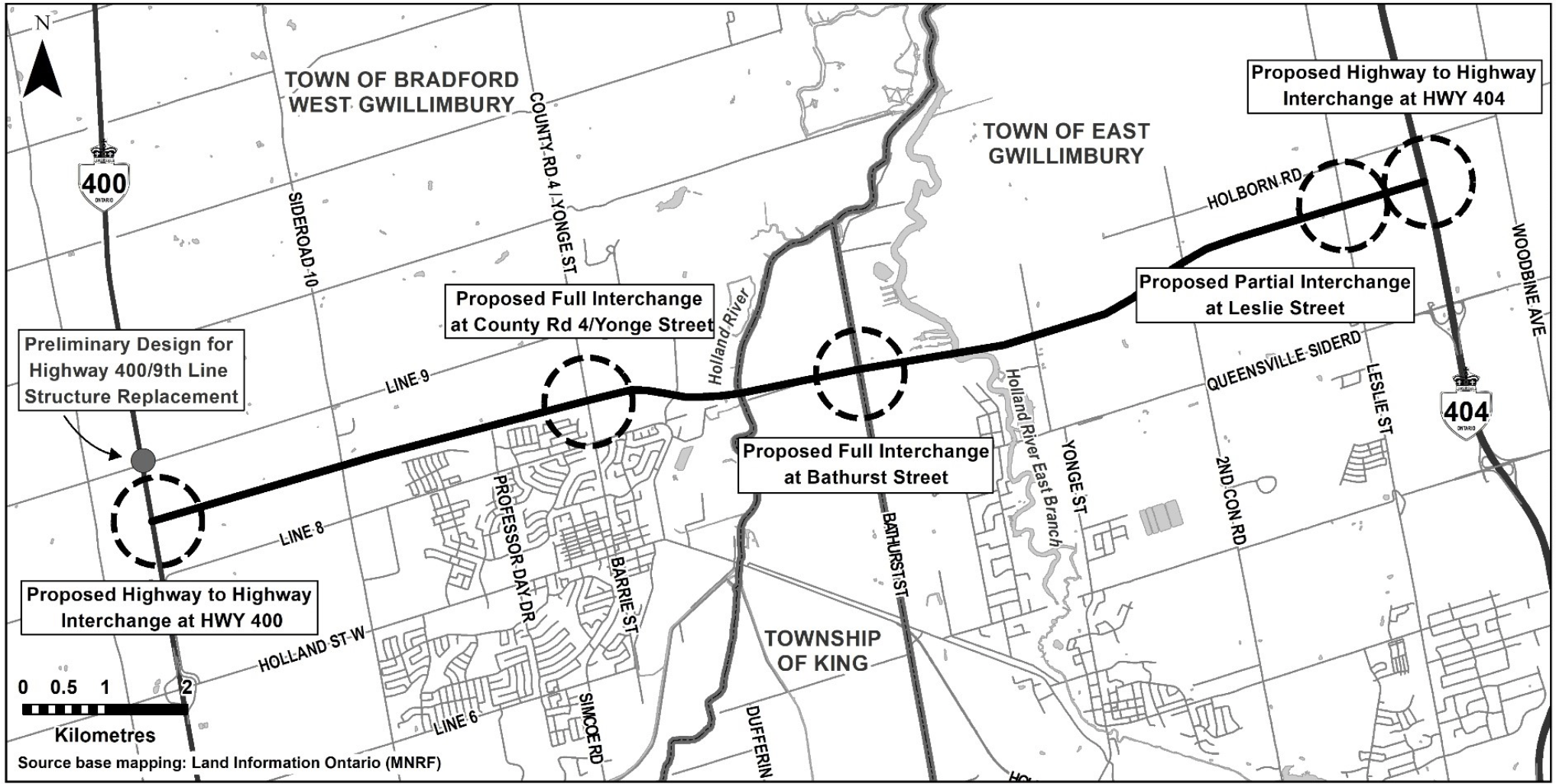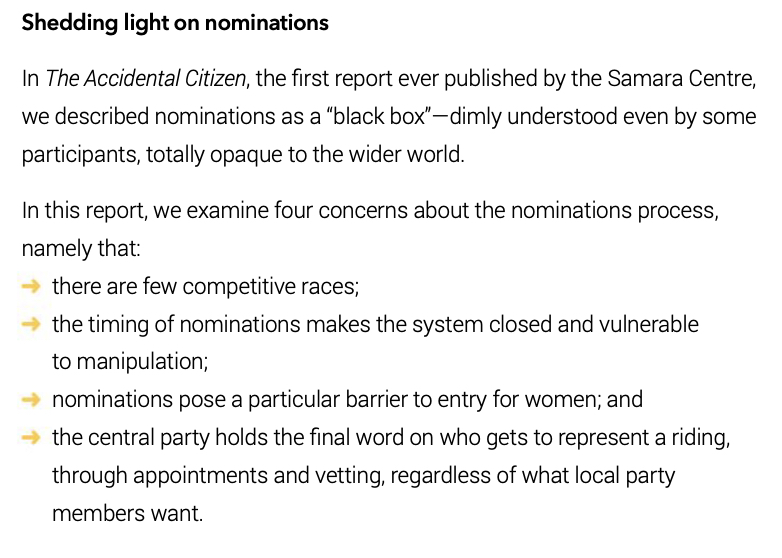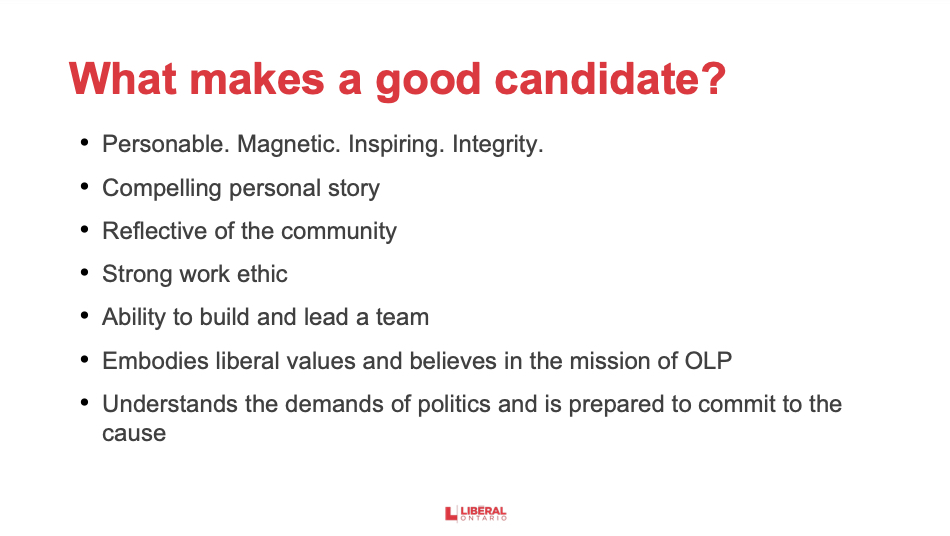- Details
- Written by Gordon Prentice

Doug Ford and Caroline Mulroney are determined to press ahead with the Bradford Bypass – a controversial scheme which opponents say will cause environmental damage to Lake Simcoe’s delicate eco-system and to prime Grade 1 agricultural lands in Holland Marsh.
Last September, the Ford Government exempted the Bradford Bypass from key requirements of the Environmental Assessment Act 1990. They said that:
“By eliminating duplication and streamlining processes, we are shortening timelines, reducing delays, and focusing the province's resources on projects that matter most to Ontario communities.”
Special Treatment
Regulation 697/21 applies only to the Bradford Bypass.
“We have exempted the Bradford Bypass project from duplicative requirements of the Environmental Assessment Act by way of regulation. The regulation sets conditions for the assessment process going forward and for continued environmental protection and consultations. No other Ministry of Transportation projects have been exempted from the Environmental Assessment Act as part of this regulation.”
Since then, the Ford Government has made a commitment to fully fund the Bypass which they say will “relieve gridlock”.
They are also carrying out early construction works in advance of all the necessary environmental studies being completed. On 26 November the Province issued a “Request for Proposals” to build a bridge crossing for the Bradford Bypass.
In its comments on the (then) draft regulation, the Ontario Public Health Association “strongly urged” the Government to reconsider exempting the Bradford Bypass from the requirements of the Environmental Assessment Act.
“The Bradford Bypass project which received individual EA approval in 2002 with conditions, but has not yet been implemented, would no longer have to meet some of those conditions. The conditions included a requirement to prepare a Transportation Environmental Study Report (TESR) and a Design and Construction Report (DCR). The TESR would have outlined: potential environmental impacts, measures to mitigate impacts, and consultation.
It is still not immediately obvious (at least to me) what environmental reports and studies are mandated and the extent to which the public will be consulted – and who decides whether or not to consult. And if that decision can be challenged. 
Last week officials from the Ministry of Transportation did their best to square the circle in a presentation to members of York Regional Council. But they fell short, obfuscating as much as they clarified.
How much will the Bypass cost?
Markham Regional Councillor Jack Heath innocently asks how much the project would cost – give or take half a billion dollars. But the officials refuse to give a figure on the grounds that it’s early days and much could change. An exasperated Heath fumes:
“It astonishes me that somebody at the Ministry can't do that (give a rough estimate)… We should have invited someone who could at least give us a general idea what this is going to cost. If the staff can’t do it then the politicians can do it and maybe we should have invited one of them.”
Georgina Mayor, Margaret Quirk, tells us that her Council is “supportive of the project” but they worry about the impact on Lake Simcoe as
“the health of the lake is of great importance to us.”
Her Council wants to involve the Lake Simcoe Region Conservation Authority but doesn't see any need to press the Federal Government to get involved.
“The Federal Government has made it clear in responses last year that they were not going to be doing that. So instead of knocking on that door again…”
Since then, of course, we have had a Federal Election and we have a new Minister of the Environment and Climate Change – but that is all lost on Georgina’s Mayor.
Hard to believe
She tells us about a letter from the Ministry sent to her Council which says
“the Bradford bypass will be located South of Lake Simcoe and will not directly impact Lake Simcoe…” 
She says that's really hard to believe.
“It will (impact). We know that. It's not rocket science. But how the Province will mitigate that is what we want to know.”
Now we hear from East Gwillimbury Mayor, Virginia Hackson, who also supports the proposed bypass believing it will
“move traffic off our local roads and on to one provincial road”
But, like Margaret Quirk, she wants to see the Lake Simcoe Region Conservation Authority have a role.
Quirk and Hackson give every impression of being supplicants, begging the Ministry to listen to the conservation authority and others while restating their own support for the bypass.
Taylor demands clarity
Now Newmarket Mayor, John Taylor, steps forward, seeking clarity in all the obfuscations and circumlocutions from the Ministry. Newmarket has already called for a Provincial Environmental Assessment and, if that’s not forthcoming, a Federal Impact Assessment.
But the Province is now moving ahead under a regulation – specific to the Bradford Bypass – which exempts it (the Province) from key requirements of the Environmental Assessment Act 1990.
Taylor wants to know what they don’t have to do now (under regulation 697/21) that they would have had to do before. He wants the Ministry to give him a table showing the differences. And what if changes are made to the project? Will there be consultations on these?
He also wants to know why the Ford Government insisted on a review of the North York Wastewater Treatment plant in East Gwillimbury after an environmental assessment process that lasted six years. And why is the very same Government taking the Bradford Bypass project out of the established EA process and fast-tracking it?
We get a torrent of explanations from the Man from the Ministry leaving us none the wiser.
Like everyone else, I wait to see the table promised by the Ministry. All will then be revealed.
Or not.
This email address is being protected from spambots. You need JavaScript enabled to view it.
See also report in Newmarket Today on 13 January 2022.
Update on 22 January 2022: From Newmarket Today: Letter to the Editor: Time to put the brakes on Ford Government's dismantling of environmental protections
Click the link below to see transcript of Thursday's presentation and debate.
Update on 10 February 2022: Federal Government will not intervene
Read more: The Bradford Bypass and its impact on the environment
- Details
- Written by Gordon Prentice
At 1.12pm on Thursday 6 January 2022 Newmarket Today posted a story telling us that members of the Newmarket-Aurora Provincial Liberal Party would be choosing their next standard bearer for the Provincial election in June in a members’ vote on 12 February 2022. 
We were also told that readers who wanted to cast a vote could join the Liberal Party free of charge provided they signed up by 5pm that very same day. (Photo from Newmarket Today)
The former MPP, Chris Ballard, decided not to run again leaving the field open to two wannabe MPPs, Dr Sylvain Roy, a psychologist and Shameela Shakeel, a psychometrist. (The Canadian Oxford dictionary tells me psychometrics is the science of measuring mental capacities and processes.)
"Feels connected"
Although he doesn’t live in the riding, Roy tells us he has worked on homelessness issues in York Region and feels connected to Newmarket-Aurora. He says he was encouraged to run by Ballard, a colleague and friend. He tells us:
“Our former MPP Chris Ballard has both endorsed my candidacy and agreed to chair my campaign. I am grateful for Chris' support and with his help and your help I am confident we can win back Newmarket-Aurora.”
Acclamation preferred
Shakeel tells Newmarket Today she would have preferred acclamation after spending some months as the only prospective candidate. This is proof positive that she is not your typical politician. If she were, she would have enthusiastically welcomed a contest while privately spitting feathers that one was necessary.
It looks as if her opponent, Dr Sylvain Roy, threw his hat into the ring at the last moment, tweeting on New Year’s day that he had decided to seek the Liberal nomination.
This gave him five days to sign up supporters. A Herculean task given that his opponent had been dug in for months if not years.
To get the party’s nomination you’ve got to get the support of the members and what better way than to recruit them yourself! 
State Secret
Leading Liberals in Newmarket-Aurora are tight lipped about membership figures. They treat it as a State secret. But we know that in some ridings Liberal membership levels are stratospheric. Getting selected there means getting elected.
I don’t know when the Newmarket-Aurora contest was called but in the 32 Liberal Party nomination contests in the period 2017 – 2021, and reported to Elections Ontario, the average time between the call of the contest and the members’ vote was 96 days. The longest contest was in York Centre which kicked off on 12 September 2017 and concluded on 8 April 2018, a leisurely 208 days. There were two contestants.
The shortest – a breathless 14 days – was in Humber River-Black Creek where, at the end of the day, there was only one contestant.
In fact, of the 32 Nomination Contests reported, eleven ended up with one contestant.
Sitting MPPs are generally acclaimed.
Costs of a contest 
Of course, it costs money to run in a contested nomination. In Newmarket-Aurora there is a $23,159.76 spending limit for each person seeking the Party’s nomination. There is also a non-refundable “processing fee” payable to the Liberal Party of $2,500 – or $1,250
“if the person is a woman”
or $500 if the person is under 30. I am left wondering why this hefty fee couldn’t be income related (although I think I understand the reasoning behind the differentials).
For the Liberals – and, indeed, for most of the other parties - acclamations are pretty much the rule. Samara, the non-partisan democracy think-tank, studied almost 3,900 nomination races held by federal political parties between 2003 and 2015 and over 70% had a single contestant.
Join the Party today and be an MP tomorrow
Here in Newmarket-Aurora, former Mayor, Tony Van Bynen, then 69, was the only candidate for the nomination in 2019, despite joining the Party earlier that year. His predecessor, Kyle Peterson, was also acclaimed. In fact you have to go back to 2008 for a contested nomination on the Federal side and that was when former Aurora Mayor, Tim Jones, defeated Gus Khouri.
On the Provincial side, Chris Ballard, was acclaimed in 2014 when he was first selected as the Liberal candidate for Queen’s Park. And as the sitting MPP he was again acclaimed as the nominee in 2018. Ward 7 councillor Christina Bisanz ran in 2007 and again in 2011 against the then PC MPP Frank Klees. I don’t know if she was acclaimed but it wouldn’t surprise me if she had been.
So, selecting candidates by acclamation is nothing new here. Despite all the talk about casting the net more widely.
Bad Practice
Personally, I think acclamation is bad practice. Nomination contests, at their best, force the candidates to open up and reveal their politics. Can they think on their feet? Are they articulate? Can they persuade? Do they have a position on the major issues of the day which is thought-through? Or are they content to read a script written by others, keeping their head below the parapet, rarely staking out a public position and defending it.
Roy and Shakeel will be giving an on-line presentation to members of the Newmarket-Aurora Provincial Liberal Party on 10 February 2022. For an hour.
The winner won’t necessarily be the best on the night.
But the one who has secured most votes.
Signed-up by 5pm on Thursday 6 January 2022.
This email address is being protected from spambots. You need JavaScript enabled to view it.
Updated on 12 January 2022 to remove description of Roy and Shakeel as both being psychologists. Only Roy is registered with the College of Psychologists of Ontario.
Update on 15 January 2022: From Newmarket Today: "This is why people who look like me and think like me don't run": Newmarket-Aurora Liberal candidate speaks out against "smear campaign"
Update on 22 January 2022: From Newmarket Today. Letters to the Editor: "Smear effort"

- Details
- Written by Gordon Prentice
A petition objecting to the proposed Bradford Bypass is now on the House of Commons website and is open for signatures.
You can sign it by clicking on this link.
The process is outlined in the graphic below.
The petition calls upon the Minister of the Environment and Climate Change to designate the Bradford Bypass project for a full federal impact assessment through the Impact Assessment Agency of Canada.
The petition closes on 6 February 2022.
Aurora-Oak Ridges-Richmond Hill MP, Leah Taylor Roy, has come out strongly against the Bradford Bypass. On 6 December 2021 Newmarket councillors unanimously passed a resolution calling on the Province to carry out an environmental assessment before any work begins. In its absence Newmarket councillors want a Federal Impact Assessment.
Newmarket-Aurora MP, Tony Van Bynen, has not said if he supports the position taken by Newmarket Council.
This email address is being protected from spambots. You need JavaScript enabled to view it.
Update on 10 January 2022: On Thursday 13 January 2022 at 9am, York Region's Committee of the Whole will be getting an update from the Ministry of Transportation Project Team on Highway 413 and the Bradford Bypass.

- Details
- Written by Gordon Prentice
This morning we learn that 46 people have died in Toronto this year as a result of gun violence. 
It is a shocking statistic. And it's getting closer to home.
Last month two men were injured in a shooting at 7.25pm on a Friday night on the Town’s Main Street South, yards away from Newmarket’s triumphal arch which welcomes people to the historic downtown.
Although the Government talks endlessly about assault weapons they are not the main problem. (Photo: the Danforth shooter, killing people)
"The majority of gun related homicides involve a handgun"
The new Public Safety Minister, Marco Mendecino, who took over from the woefully ineffectual Bill Blair, told the House of Commons Public Safety Committee on 16 December 2021.
“It is a fact that the majority of gun-related homicides involve a handgun, and that's why our government is committed to investing one billion dollars to support those provinces and territories that want to ban handguns.”
The minority Liberal Government elected last September (on 32.6% of the national vote) pledged in its Platform to:
“Set aside a minimum of $1 billion to support provinces or territories who implement a ban on handguns across their jurisdiction, to keep our cities and communities safe.”
The mandate letter sent by the Prime Minister to Mendecino on 16 December 2021 asks him to deliver on this commitment by:
“Providing financial support to provinces and territories that implement a ban on handguns across their jurisdiction”
Reintroducing Bill C21
There is no mention of reintroducing Bill C21 which sought to tighten up the law on firearms. The Bill was lost when Trudeau called the Federal Election for 20 September 2021 and Parliament was dissolved.
Had it become law Bill C21 would have required licensed handgun owners to comply with rules, set by the municipality where they live, for the storage and transportation of their handguns or risk losing their licence. The Commissioner of Firearms would maintain a publicly available list of municipalities “in which such requirements and prohibitions apply”.
However, the Liberal Platform changed at the last election. Instead of allowing cities and municipalities to decide whether to ban handguns (an absurd proposition in itself) the power is to be vested in the Provinces and Territories. Now the initial absurdity is compounded. Toronto has repeatedly called for a handgun ban. But the Province under Doug Ford’s Progressive Conservatives has ruled that out. 
So, what should be done?
The absence of any reference to new legislation on handguns in the Prime Minister’s mandate letter to Marco Medecino suggests it may be possible to introduce new requirements for licence holders by administrative action – once the Provinces have passed the necessary legislation. But what form that Provincial legislation should take is a bit of a mystery – at least to me.
Ryan Tumilty writing in the National Post on 24 November 2021 says:
“In the last Parliament, the Liberals introduced, but did not pass, a sweeping gun bill that included measures limiting the capacity of rifle magazines, banning certain weapons and allowing municipalities to ban handguns within their jurisdiction. The bill died with the election in August and the Liberals will have to reintroduce the legislation in this Parliament.
A provincial ban could operate differently because provinces have more constitutional authorities and might not need federal legislation to ban handguns. But the Liberals could also pass federal legislation alongside provincial rules that would prevent people in those provinces from getting a licence for a handgun.”
Let's get on with it
If Federal legislation is required (and I assume it is) then let’s get on with it.
Even if what is being proposed is half-baked, it is better than nothing. The numbers are there to get a Bill through Parliament and on to the Statute Book.
The NDP backed the original proposal to allow municipalities to ban handguns and even claimed the idea as their own. They are unlikely to stand in the way of Trudeau's new, reworked commitment which gives Provinces the final say in deciding handgun policy within their own jurisdictions.
After the tragedy of Portapique, we could see one of more of the Atlantic Provinces effectively banning handguns while here in Ontario - so long as Ford is running the show – there will be no change to the status quo.
Patchwork of rules
We could see a patchwork quilt of rules across Canada when, instead, there should be uniformity across the country. The Mayors of Newmarket and Aurora, John Taylor and Tom Mrakas, believe the opt-in, opt-out policy is impractical.
Newmarket-Aurora’s Liberal MP, Tony Van Bynen, disagrees.
The MP talks about gun violence in his latest flyer (December 2021):
“This starts with tackling the rise of gun violence in our biggest cities. Our communities should be safe and peaceful places to live and raise children, but gun crimes are increasing. In May 2020, we took action to put a ban on the use, sale or import of assault style weapons most often used in mass shootings.
“While this was a strong initiative, we know there is still more to do. This is why we are going to implement a mandatory buyback of all assault style weapons and work with the provinces and territories that want to ban handguns.”
This is the man who draped a tartan scarf on his front door for 48 hours in memory of those slain in Nova Scotia – Canada’s worst mass murder – and posted the photo on his Facebook page so we could see his grief.
A more fitting tribute would be for Van Bynen to make it a personal priority to help deliver a handgun ban – even one as incomplete and as flawed as the one being championed by the Prime Minister.
This email address is being protected from spambots. You need JavaScript enabled to view it.
See more here on the debate on handguns
- Details
- Written by Gordon Prentice
My good friend Peter Pike died on 27 December after being unwell for some time. He was 84. 
Peter was the Labour MP for Burnley, an industrial town in Lancashire in the North West of England, from 1983 until 2005 when he retired from the House of Commons - but not from politics.
Peter’s maiden speech on 28 June 1983 marked him out as a man of principle, ready and willing to defend the interests of Burnley to the last.
I first got to know Peter in 1991 when I was selected to fight Pendle, next door to his Burnley constituency. I looked on him then as a kind of big brother - the long-established and worldly-wise MP and me the new kid on the block.
I kept in touch with Peter over the years and last heard from him in October in the wake of the terrible news of the murder of David Amess.
Genuine
Peter was a genuine person with no side to him. He got on well with people and I never once heard him unfairly criticise anyone.
Peter was a Labour stalwart to the core. He believed Britain needed a strong, united Labour Party. He told me he was never the greatest Tony Blair fan but it was always a pity that Gordon Brown and Tony Blair did not work better together. He said Brown's obsession with wanting to be Leader was his weakness.
Peter was incredibly industrious. His constituency casework was a top priority and the day-to-day experience of helping people resolve the problems they had with the State and its agencies informed his politics.
I recall him standing up in the Commons, often slightly dishevelled, holding forth on the scourge of low pay or on the problems facing manufacturing or local transport or whatever the issue was. If a policy affected Burnley you could count on him to be on his feet, defending the town and its people.
Peter remained politically active when he left the Commons, chairing the local constituency Party until 2015 when he said he wanted to hand over to a younger person with more energy.
Westminster bustle
He liked the bustle of Westminster but the place changed when Covid struck. He told me:
“Parliament is very strange now as it is almost empty - it would not be my cup of tea at all. That said I still miss it!”
I have many vivid memories of Peter.
In 2003 he led a CPA (Commonwealth Parliamentary Association) delegation to St Vincent and the Grenadines in the Caribbean. I was on it. (Photo: saying hello to the children at an elementary school in Kingstown, SVG)
On our itinerary was a visit to the central prison that must have dated back to Napoleonic times. The walls were six feet thick. We were being taken up to see the tiny cells for the condemned men (though no-one had been executed there for years). To get there we had to ascend a steep flight of stone steps with no bannisters. Down below on our right was an open exercise area crammed full of bare-chested prisoners, gazing up at us.
Address the prisoners!
The uniformed Prison Governor with his swagger stick led the way followed by Peter, the delegation leader. I was next in line with the other MPs in single file behind. Half way up the stairs the Governor swivelled round and barked out at the top of his voice:
“Mr Pike, Sir!!! Would you care to address the prisoners!”
None of us had been given any warning that this was on the programme. I looked at Peter - thanking God I was not in his position - and he handled it with tremendous skill. There was a moment when I could see his mind racing as he surveyed the ranks of prisoners below and then he settled into his theme. He too yelled at the top of his voice:
"The conditions here are terrible!”
He tells them the prison is cramped, overcrowded and totally out of date. He vows to take up the issue as a priority when we get back to London.
And he does.
Peter was a good friend to me and to many others. I shall always remember him with great affection.
Peter Pike 26 June 1937 – 27 December 2021
This email address is being protected from spambots. You need JavaScript enabled to view it.
Page 79 of 284